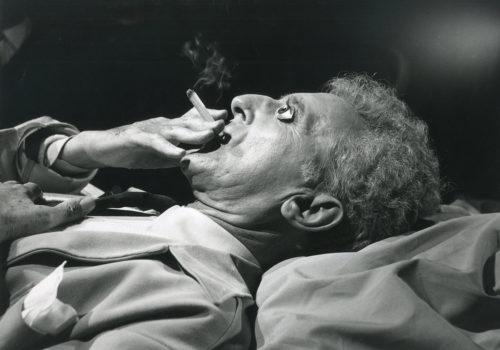For PHotoESPAÑA 2024, LOEWE and LOEWE Foundation present at Leica Gallery Madrid an exhibition showcasing the wide-reaching impact of Surrealism on photography, marking the centenary of André Breton’s Surrealist Manifesto published in 1924.
In the wake of World War I and against the backdrop of Freudian psychoanalysis, Surrealism looked to the unconscious world of dreams and inner desires, embracing the creative possibilities of the human psyche. This exhibition illustrates how photography provided a tool for manipulating the representation of reality, with various photographic techniques – from double exposures, sandwiched negatives, photomontage and solarisation, to the use of absurd props and theatrical lighting – proving vital for Surrealism’s quest to distort rational perceptions of the world, in order to reconfigure our vision of ourselves and cast a more astute gaze on what is real.
Among the works is an untitled photo of a hooded woman next to a death mask from Kati Horna’s (1912-2000) Ode to Necrophilia series (1962) – a significant example of Horna’s explorations of desire amid loss and grief. In addition to Surrealist icons like Horna, Leonora Carrington (1917-2011) or Dora Maar (1907-1997), the exhibition showcases numerous other photographers less commonly considered part of the Surrealist canon but who nonetheless adopted playful, experimental approaches inspired by Surrealism; these include practitioners like André Kertész (1894-1985), Horst P. Horst (1906-1999), Tina Modotti (1896-1942) and Edward Weston (1886-1958). Known primarily as a fashion photographer, Horst P. Horst’s Robert Wilson on Paul Walter Chair (1990), for example, depicts a man on a supersized chair against a backdrop of painted clouds, pushing the real against the artificial.
Utilising close-ups, body-altering costumes and unusual poses, shots of the dance choreographer Martha Graham by Imogen Cunningham (1883-1976) and Barbara Morgan (1900-1992) are charged with a powerfully Surrealist sensibility, as are portraits of the playwright Jean Cocteau by Berenice Abbott (1898-1991), Lucien Clergue (1934-2014), Philippe Halsman (1906-1979), Germaine Krull (1897-1985) and Dora Maar.
The longer-term legacy of Surrealism is evident from later works by artists such as Hiro (1930-2021), Ana Mendieta (1948-1985), Marion Scemama (b. 1950), Kiki Smith (b. 1954), David Wojnarowicz (1954-1992) and Francesca Woodman (1958-1981). Highlights include Francesca Woodman’s otherworldly black-and-white photos of female figures and David Wojnarowicz’s unique mixed-media work New York (1988) – a collage pairing a steam train and skeleton that borrows from the aesthetic of x-rays.
Nodding to the International Exhibition of Surrealism that took place in Mexico City in 1940, the exhibition highlights Latin America’s involvement in and contribution to Surrealism. Works by Mexican artists like Lola Álvarez Bravo (1903-1993), Manuel Álvarez Bravo (1902-2002), Rosa Covarrubias (1895-1970), María García (b. 1936) and Graciela Iturbide (b. 1942) illustrate Surrealism’s relationship with a region that was also home to a creative imagination that leaned towards the marvellous and fantastical – most notably, in the rise of magical realism.
Surrealist Centennial
Until September 14th, 2024
Leica Gallery Madrid
C/ Ortega y Gasset 34
28006 Madrid
















